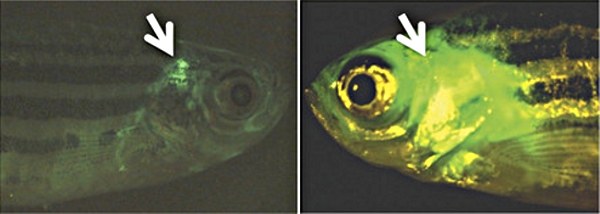Leukemia is a type of cancer that causes an unusually high concentration of white blood cells in the body. In this particular study researchers targeted a leukemia called “T-cell acute lymphocytic leukemia” (T-ALL for short), which is the most common type of leukemia found in children. It’s characterized by a very quick population explosion of immature white blood cells in the body and if left untreated can be quickly fatal (in as short as a few weeks).
Zebrafish, interestingly enough, can also contract T-ALL. What scientists did was to specifically breed an aggressive form of T-ALL into zebrafish using a genetic technique called serial transplantation. Over the course of multiple generations and transplantations, T-ALL became more and more severe in the zebrafish. These particular zebrafish were also genetically modified so that their white blood cells would fluoresce green (pictured above). What this allowed researchers to do was to visualize the severity of T-ALL in a given fish and then search for unique genetic signatures of the disease in that particular fish.
The ultimate goal of this research was to find new genetic signatures for T-ALL and then apply this knowledge to bone marrow biopsies of infected patients. This would then help doctors tailor the treatment regime with the specific form of T-ALL found in a given patient.
(via The Salt Lake Tribune)










0 Comments